All you need to know about a CRM system, how it works, and what benefits it brings to your business.
This article will help learn everything there is to know about CRM software. You’ll find out what it is, what types of CRM are out there, what benefits CRM brings, who can use it, how it works, and how to implement it.
From a complete CRM newbie to a CRM know-it-all. In one guide. Let’s go!
What is a CRM?
A Customer Relationship Management (CRM) system is a piece of software that lets businesses collect, store, and manage their lead and customer information to build and maintain relationships with them. Essentially, it’s an organised repository for customer data and all the processes associated with its management.
Cloud-based vs. on-premise CRM
There are many different factors that can be used to classify CRM software. tThe most common is the location of the system's servers. Based on that, we can say that there are cloud-based CRM systems and on-premise CRM systems.
Cloud-based CRM (also known as Software-as-a-Service (SaaS) CRM, online CRM, and Web CRM) is a CRM solution where the application and data are all hosted remotely, on the CRM vendor’s own servers. The system can be accessed from anywhere in the world via the internet.
On-premise CRM, on the other hand, is a type of CRM software that companies build in-house for their own usage. In this case, both the data and the application itself are located on the company’s own servers and can only be accessed on the spot.
Today, the popularity of cloud-based CRM software is growing rapidly: the percentage of cloud-based users was just 12% in 2008, then jumped to 62% in 2018 and has accelerated to 87% these days.
Advantages
Disdvantages
Cloud-based CRM systems
✅ No software licensing costs
✅ Data is stored and handled externally; no new overheads
✅ Upgrades and maintenance are handled externally
✅ A small cost for services
✅ Data can be accessed from anywhere in the world
❌ You don’t have complete control of your data and systems
❌ The possibility of security breaches
❌ Lack of autonomy in upgrades
❌ Reliant on the quality of your CRM vendor’s customer support
On-premise CRM systems
✅ Offers a great degree of control over the system and the data stored within it
✅ Better security as data is more protected from ransomware and hacker attacks
✅ Initial investment pays off over time
✅ Can be custom-built to meet all the business needs exactly
❌ The system can’t be accessed from anywhere rather than your location or IP address
❌ An extremely expensive initial investment
❌ You’re responsible for the security and backup of your data
❌ Requires dedicated IT staff for maintenance and support
Back in the day, it was also possible to differentiate between five types of CRM systems depending on the functionality they offer: analytical CRM software, operational CRM software, collaborative CRM software, campaign management CRM software, and strategic CRM software.
Today, this approach is dated as the majority of good modern CRM vendors offer software that combines a wide range of features. Hence, they enable all of those processes.
Why CRM is important for growth
Some companies still rely on spreadsheets and manual processes. The limitations of these methods become obvious as a business scales. Your company won't be able to grow effectively without implementing a CRM. Here’s why.
Inconsistent sales processes
Your sales team lacks a standardised approach to managing leads and closing deals without a CRM. This inconsistency, first, hurts productivity. Second, it makes it difficult to forecast revenue and evaluate the effectiveness of your sales strategies.
Wasted resources on routine tasks
Routine tasks like data entry, lead follow-ups, and lead routing consume your team's time. A CRM automates these tasks. It lets your team focus on aspects like negotiations and closing deals.
Poor customer service
Tracking a customer's history with your company becomes a Herculean task without a CRM. The lack of information can lead to repeated questions and a poor customer experience. A CRM centralises all communications. It makes it easier for your sales team to provide personalised service.
Inability to track sales performance
Try measuring your sales team’s performance without a CRM. You won't know who's meeting their targets or how quickly leads are being converted. A CRM provides real-time sales reports and analytics. It’ll aid you in identifying areas for improvement and rewarding top performers.
High customer churn rate
If your customers aren't engaged post-sale, they'll churn. A CRM system can automatically send follow-up emails, and flag leads showing early signs of churn. This lets you take preventive measures before people leave.
Who can benefit from using CRM?
In the past, there was a myth that a CRM system was for salespeople only. Today’s CRM systems have such a wide range of features that they can be used by every team within the organisation to standardise data, avoid data aggregation, and having access to the same data.
CRM for sales teams
The sales team uses CRM software to build, manage and visualise sales pipelines. They also use it to qualify leads, analyse past sales performance and forecast future deals. A CRM can also help create reports, personalise offerings, and convert leads into paying customers faster. With the help of a CRM system, salespeople can also automate routine tasks that lead to higher conversion rates. Tasks such as:
- Lead distribution
- Lead nurturing
- Follow ups
- And more!
CRM for Marketing Teams
The marketing department can use CRM software to segment its audience better and run more successful personalised campaigns. This is particularly true for CRM for marketing agencies, where tailored outreach is paramount.
On top of that, data from the CRM system allows marketers to better grasp their ideal customer profile (ICP) and map their customer journey with more details. It also helps in figuring out the optimal number of touchpoints and maximising the impact each of them has on their customers.
As a result, businesses increase the number of marketing qualified leads (MQLs) and nurture them more effectively.
CRM for Customer Support
Customer support can also find value in implementing a CRM system. It allows them to easily standardise the onboarding process, speed up the response time, and offer more accurate solutions to customer problems.
This enables a proactive customer success approach and helps your team establish and foster relationships with clients.
This is all because customer data becomes easier to cross-link with a CRM. With the history of communications, collection of call records, documents, and salespeople notes all available at a click away, it became significantly easier for customer support representatives to understand the customer's problem, as well as their history with the company.
CRM for Managers
The C-Suite and business owners can use CRM data to make more informed decisions. Having reliable, up-to-date, and easy-to-interpret data at hand is crucial in the day-to-day running of a business. The CRM's reporting functionality allows business owners to track performance metrics, identify sales trends, allocate resources effectively, and make data-driven decisions.

With CRM data, you can keep tabs on the team as you can see what each of your employees is caught up with at any moment. Moreover, you also have access to a detailed overview of the tasks completed over a certain timeframe. This makes it easier to see which actions lead to successful sales and which ones hinder the sales process. You can then use this information to conduct performance appraisals, calculate commission, and coach your team.
What types of businesses need CRM?
The answer is simple. You can benefit from implementing a CRM solution regardless of the industry your business operates in. It depends on a CRM system, of course. NetHunt CRM, for example, works really well for these industries:
👉Professional services
👉 Startups
and more..
But really, everyone can benefit from a CRM. It’s always great to have your database organised, your business processes structured, and your sales automated.
As for the size of your business… Do small businesses really need CRM?
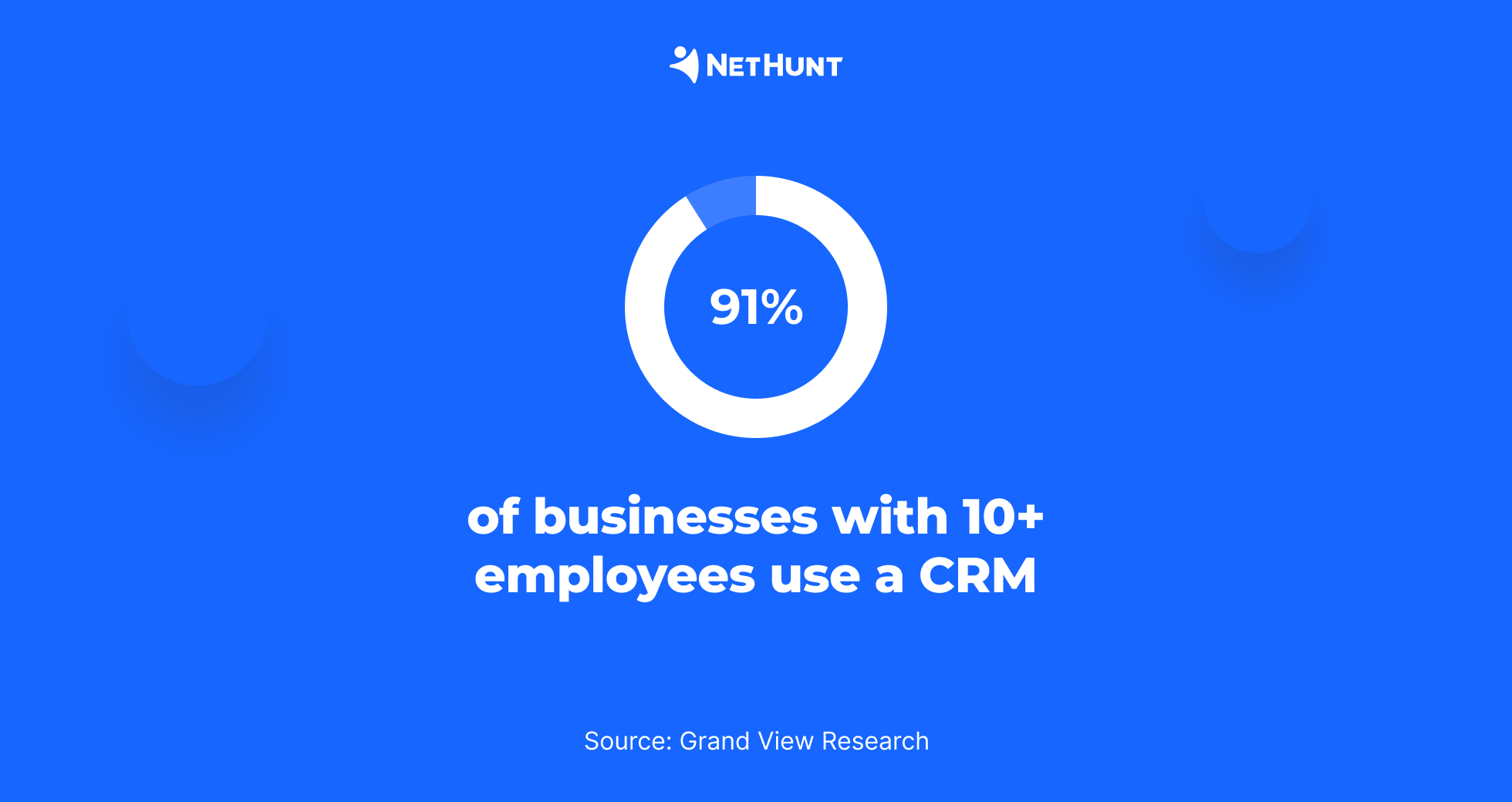
Long gone are the days when CRMs used to be big-business-only software. Today, there are thousands of CRM solutions for businesses of all sizes — you can find a system for solopreneurs, tiny startups, and large enterprises. It all comes down to your CRM's functionality and how well it can be customised to bend around your specific business needs.
Key features of a CRM system
Not every CRM system has all of these features. There are also CRM features that this list doesn’t have. With the variety of CRMs there’s something for everyone. That also means that most CRM systems aren’t for everyone … For example, real estate CRM’s tend to have features like in-built property landing page builders. Some even have in-built property searching tools built into the CRM.
Without further ado, let’s get to the key features of a CRM system.
Contact management
The capability to effectively manage your customer database is at the core of every CRM system. A decent CRM, such as NetHunt CRM, provides features such as duplicate prevention, automatic data enrichment, and an in-depth overview of interaction history. This guarantees that your client database is clean and well-organised. The customer card that’s created contains all the necessary information about your prospects or clients, such as their name, job title, contact information, and any other bit of information you deemed necessary to collect.
Lead Management
Any CRM system must come with an ability to manage leads. Powerful integrations allow you to capture leads, custom filters and tags allow for better segmentation and qualification, and the workflow functionality allows for automated lead nurturing processes.
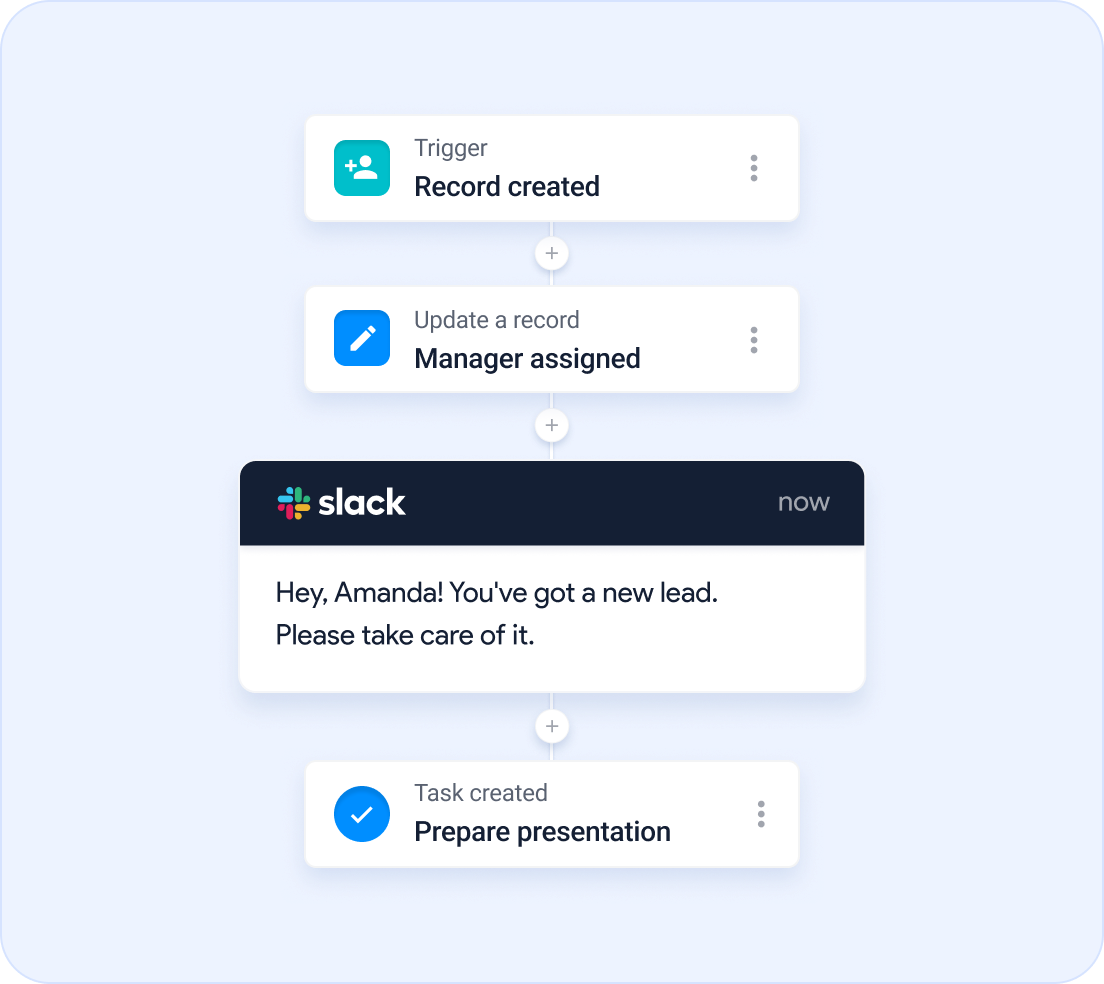
Email Marketing Functionality
This varies from CRM to CRM, but usually involves features such as:
- Creating and saving email templates
- Launching email campaigns
- Tracking key metrics like open and click-through rates
- Personalising emails with macros
This functionality allows you to personalise your campaigns and measure their impact directly. You won’t ever have to leave your CRM suite and gather data from other email marketing tools to add it to your CRM!
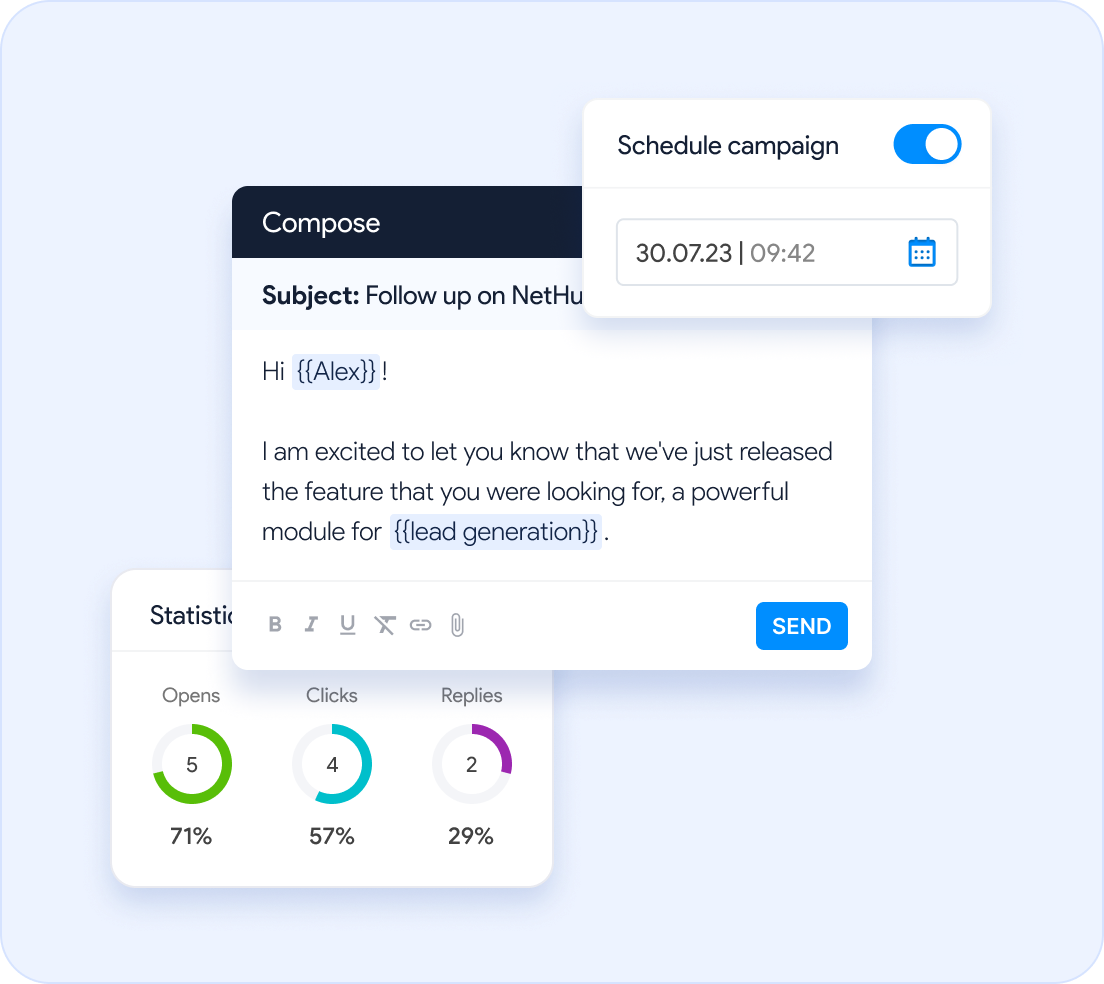
Pipeline Management
With a CRM, you can visualise your sales pipelines and give them a whole new, and easier to operate look. With CRM’s pipeline management functionality, you have a much clearer picture of the stages of your pipeline, from “new” up to “won”, as well as a visual representation of what the changes in your pipeline have been lately.
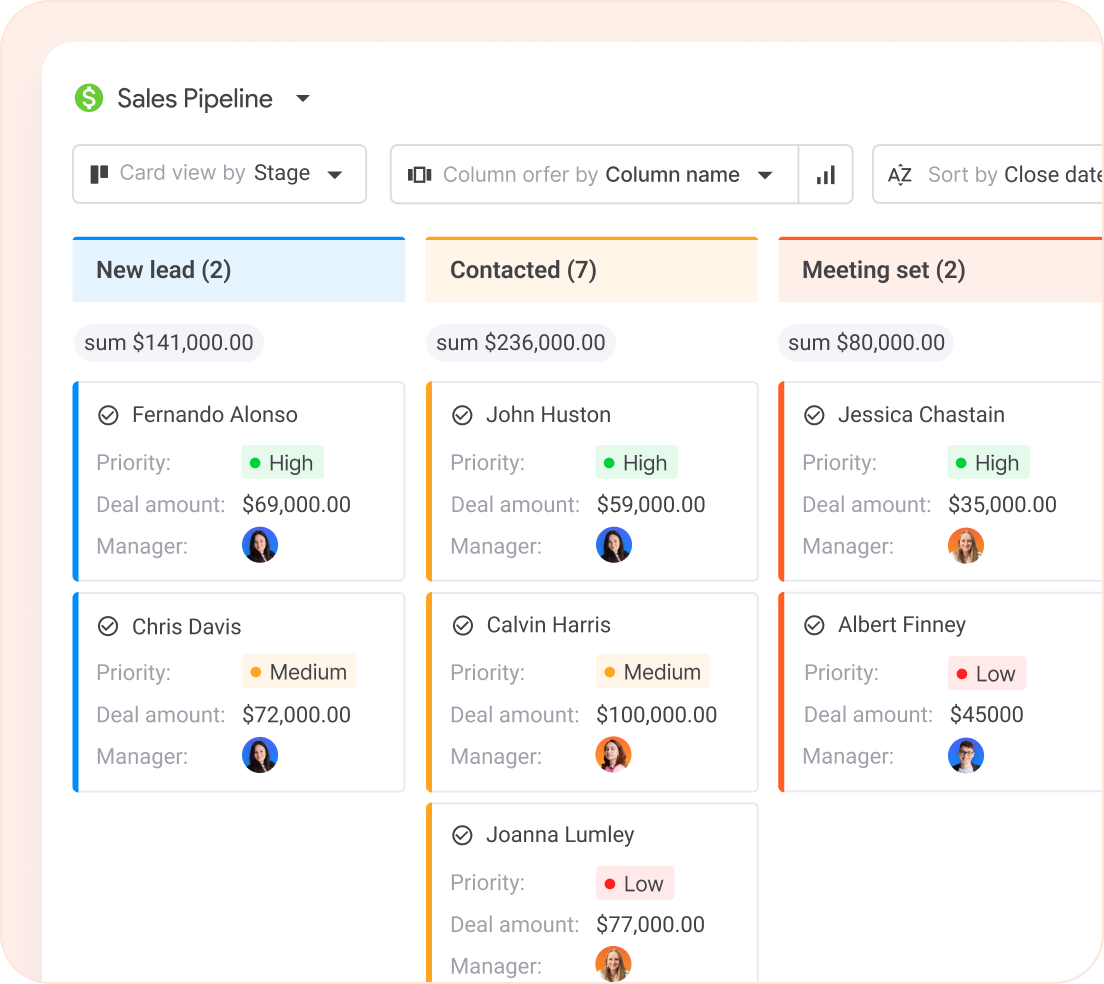
Sales Automation
Repetitive, no-brainer tasks suck; we can all agree on that. A great CRM offers a solution to that problem. For example, with NetHunt CRM, you can automate tasks like lead distribution, follow-ups, cold emails, and lead stage changes, freeing up your sales team's time to focus on more strategic activities.
Reporting and Analytics
CRM systems reporting and analytics capabilities are one big cherry on the CRM cake. Allowing you to track metrics such as conversion rates, sales forecasts, team performance towards their goals and more. You can also check the activity of your team and have a much more detailed overview of your customer funnel, allowing you to spot bottlenecks from a mile away.
Collaborative Functionality

A CRM system also serves as a collaborative platform, bridging the gap between the departments in your business. Features like task assignments, mentions, and shared databases ensure everyone is on the same page. Tag colleagues when you need their help, leave comments for your team, and assign tasks associated with customers without going into details.

How much does a CRM cost?
In the past, when the CRM software market wasn’t so competitive, a CRM solution was an expensive tool. Today, as the market grows and more vendors enter it offering all kinds of generic and specialised CRM systems, customer relationship management becomes significantly more accessible.
As a rule of thumb, CRM pricing depends on the features a CRM offers. The more features and extra modules a CRM offers, the more expensive it gets.
There are also different subscription-based pricing models for CRMs:
- Flat-rate pricing: a single product and a fixed set of CRM features at a fixed price per month.
- Tiered pricing: packages with various features that are available at various price points.
- Usage-based pricing: a base rate with an additional usage rate.
- Per-added-module pricing: a base rate for the standard CRM; functionality can be expanded upon request for a higher price. Per-user pricing: a fixed price for every user of the CRM. Currently, it’s the most widespread pricing model in the CRM software market.
When should you implement a CRM?
Just to be clear, we’re talking about a tool that will:
- Boost your sales
- Help you keep your database organised and clean
- Foster collaboration
- Provide more insightful data
- Automate routine processes
- Improve customer relationships
and many other benefits to count…
Of course, the best time to implement a CRM system is yesterday. The other best option — right after reading this article. Think about it.
Why wouldn’t you do a service to every employee of the business (yourself included) by giving them an environment that allows them to focus more on mastering their tasks and responsibilities than administrative work?
On top of that, implementing a CRM is also a service to every one of your customers. Thanks to access to a cleaner, better organised, and more complete database, your employees will be able to provide their customers with stellar customer service.
Benefits of cloud-based CRM software
Depending on the CRM software you choose and the features CRM provides, cloud-based CRM software can bring your business the following benefits.
It centralises your customer data
Modern businesses acquire customer data from a wide variety of sources. Want to stay afloat? Keep growing your business. Adopt an omnichannel approach and ensure that you generate leads from several different sources.
If you keep using spreadsheets or other old-school methods of data capture to keep track of everyone you interact with, you’ll quickly notice that it’s a near-impossible undertaking. Not only does it take a lot of time and effort but it also increases the risk of missing crucial details and, as a result, sales opportunities.
CRM software helps businesses to centralise data from email, social media, phone, web forms, offline lead generation, and other sources and store it safely in one place.
It makes your data more structured
On top of storing all your customer data in one place, you also need to organise it. With an organised database, you can find all the important information in a matter of a few clicks and speed up your responses.
Most modern CRM solutions also allow their users to segment their contact database by adding tags, as well as enrich the data on their customer with additional details. Both of these result in a significantly higher degree of personalisation for your outreach campaigns.
Additionally, you can link customer records to company records or deal records to create a more complete view of the company structure. For example, by clicking on a company record, you could easily see which employees of that company you already have added to the database, as well as all the interactions with these employees.
It improves the quality of your data
CRM software automatically logs every interaction your sales reps have with customers. This means that no details of your communication go missing due to your salesperson deciding it’s not important. Every call, email, messenger app message, document, and other form of communication is neatly stored and centralised in a single place.
You can also improve the quality of your data by making certain fields required in the CRM. This means that a new record cant be created, edited, or moved along the pipeline without the salesperson first filling in the necessary fields.
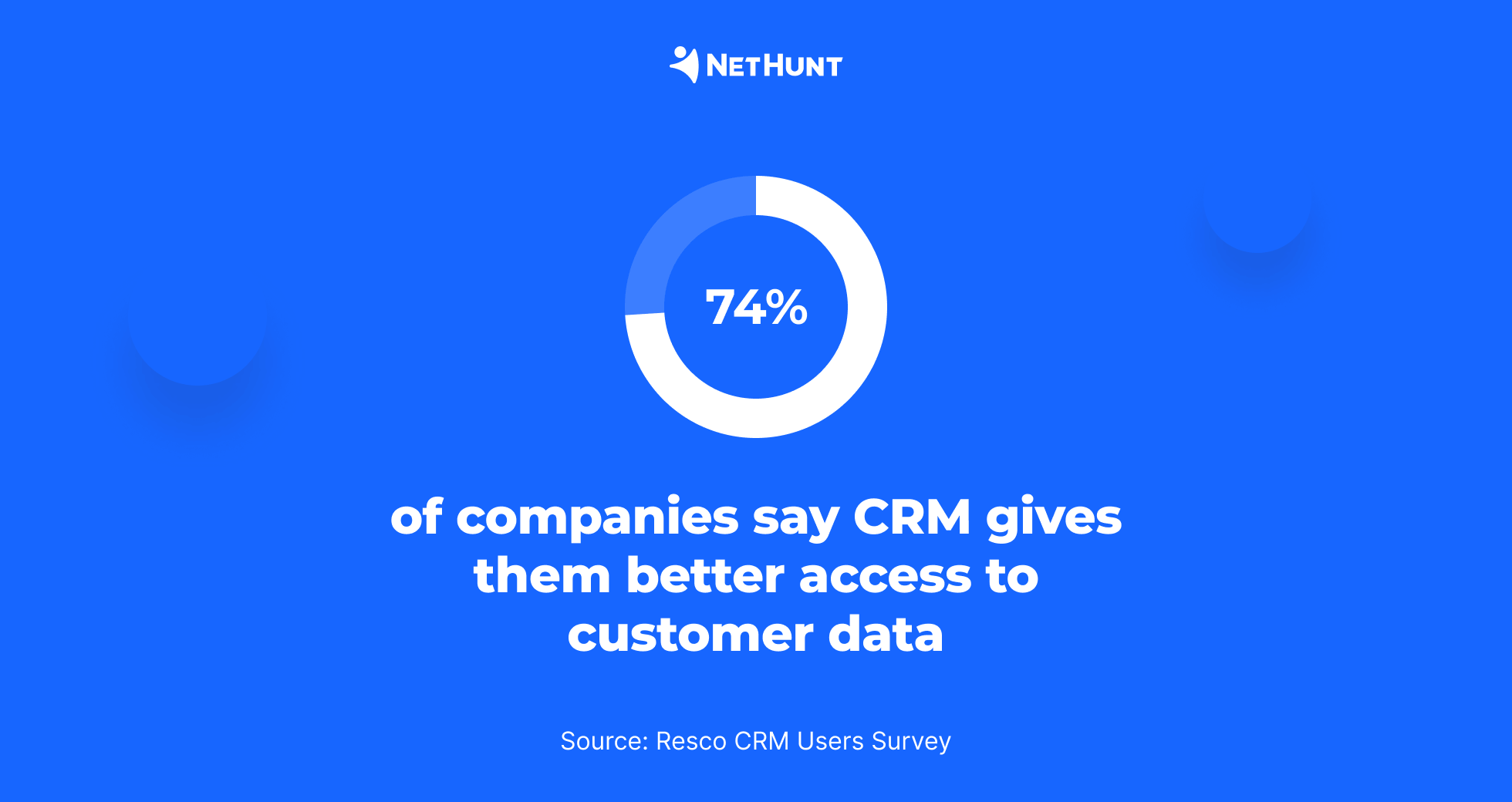
Some CRM systems also offer advanced functionality such as duplicate management, which automatically finds duplicate leads and clears up the database. Whenever you add a new contact to the database — either manually or automatically — the system notifies you of this and gives you an opportunity to merge contacts.
It increases your data security
Cybersecurity is important. It’s nothing to argue about. Modern CRM systems are built in appliances to data privacy and security laws. Moreover, vendors put in the extra effort to implement the most advanced security developments to further secure the data you store and protect it from hacker attacks and malware.
Thanks to permission access management, you can also limit the data certain people from within or from outside of your organisation can view and edit. This means that only certain roles see certain fields. For example, accounting only sees the fields related to their work, such as commission amount and deal sum.
It improves communication with customers and prospects
One of the main things a CRM allows you to do is to visualise your sales pipeline. With a visualised sales pipeline, your sales reps always know when to reach out to leads and customers. You can create different views for leads and customers who need to be followed up on, who haven’t been contacted in a long time, or those who live in a specific location that your sales rep on a field trip can visit.
Besides, thanks to database segmentation and complete customer records in your CRM, you can craft better offers that your leads won’t be able to turn down.
It increases your sales teams productivity
According to a study by Time Management Sales, salespeople spend just 37% of their time actually selling. The majority of their day — the other 67% — is wasted on repetitive, no-brainer administrative tasks such as manual data entry. These tasks are important, however they don’t contribute to the bottom line at all. These are the kinds of tasks that a CRM aims to tackle with it’s automation functionality.
A robust CRM suite would solve that with its automation functionality. Modern CRM systems can automatically:
- Capture leads
- “Warm them up” with cold outreach
- Move them down the sales funnel based on certain criteria
- Assign them to managers
- Create tasks
- Send notifications
and much more!
This lets your teams focus on other, more important, money-generating tasks and make them more efficient.
When sales reps get this no-brainer work taken off their hands and passed onto a machine, they can focus more on activities that generate revenue for the business.
It improves your service
CRM systems let your customer-facing staff maximise their potential when talking to customers, making the best impression possible as a result. This is because CRM software stores every customer interaction's details in the database, and the rep talking to the customer can access it during the call. By knowing their particular case's intricacies, they can offer a better solution and do it promptly.
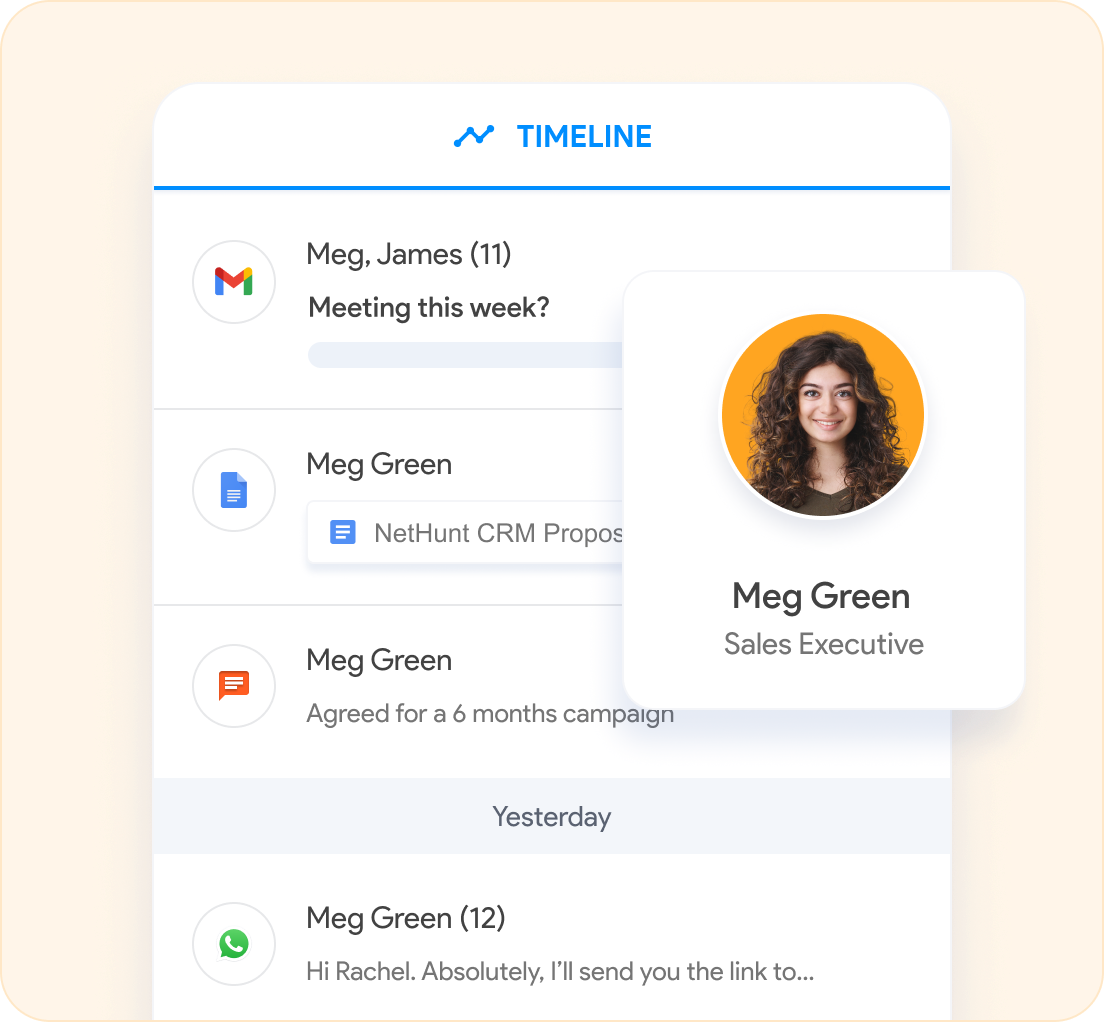
CRM software helps your customer support reps to react to requests quickly. You can set up automated notifications and task assignation on a round-robin basis so that there’s no stalling, and the process kicks off immediately.
Finally, it also makes your onboarding activities more efficient. If your CRM system supports drip email marketing, you can set up a sequence of onboarding emails that will be sent out to new users of your product immediately after they sign up.
It increases customer retention
CRM helps to achieve a higher quality of communication with customers, produce better personalised offers, and better customer service. It helps increase customer satisfaction and, therefore, minimise customer churn.
Moreover, it also standardises the customer journey for every lead that enters your sales pipeline, decreases user friction, helps to identify disengaged customers early, automates assessment calls, automates subscription renewal, and helps to identify reasons for churn of other customers.
Finally, CRM software helps to build and maintain stronger relationships with customers. You can set up tasks and reminders — or even automated emails — to remember about all the important dates, anniversaries, and holidays and congratulate your customers on those.
Find out how to reduce customer churn with the help of CRM strategies in this article!
It makes your reports more accurate
Sales reporting is an essential part of the sales process. But, unfortunately, it’s also one of the most tedious ones. CRM software offers sales reporting functionality that automates the process and creates clean, reliable reports for you in a matter of a couple of clicks.
You can customise those reports and pivot the information that is of interest to you at each given moment. Moreover, with CRM, you can rest assured that the process is standard and you’re not missing any details due to human error.
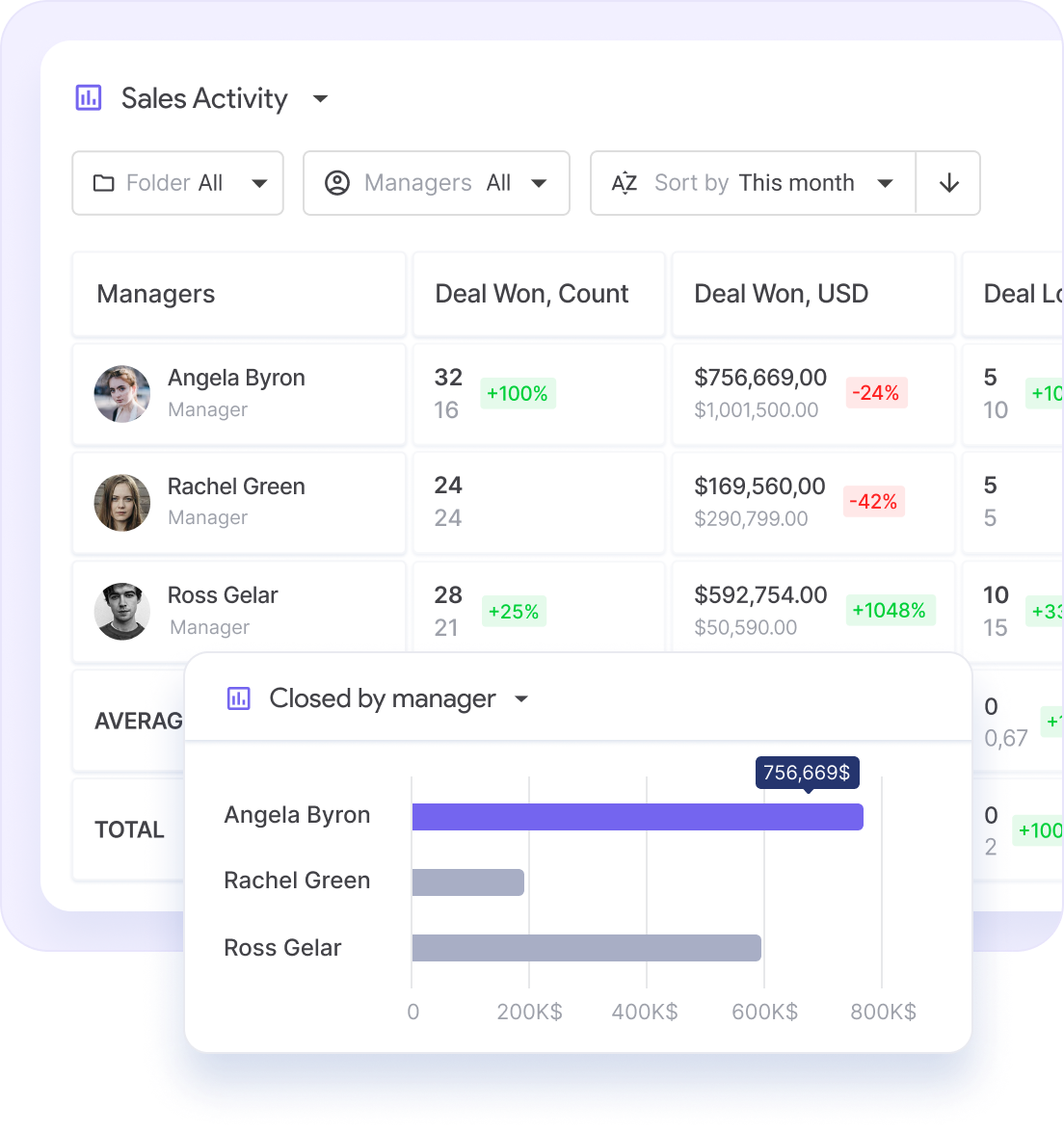
Besides, CRM systems with email marketing functionality, email tracking, in particular, allow you to assess the effectiveness of your email marketing campaigns and the impact they have on your sales pipeline.
Make better data-based decisions
With access to clean, relevant, and reliable reports, you can make better-informed decisions. By seeing what works and what doesn’t, you can tweak your strategy and focus on the activities that have the highest ROI.
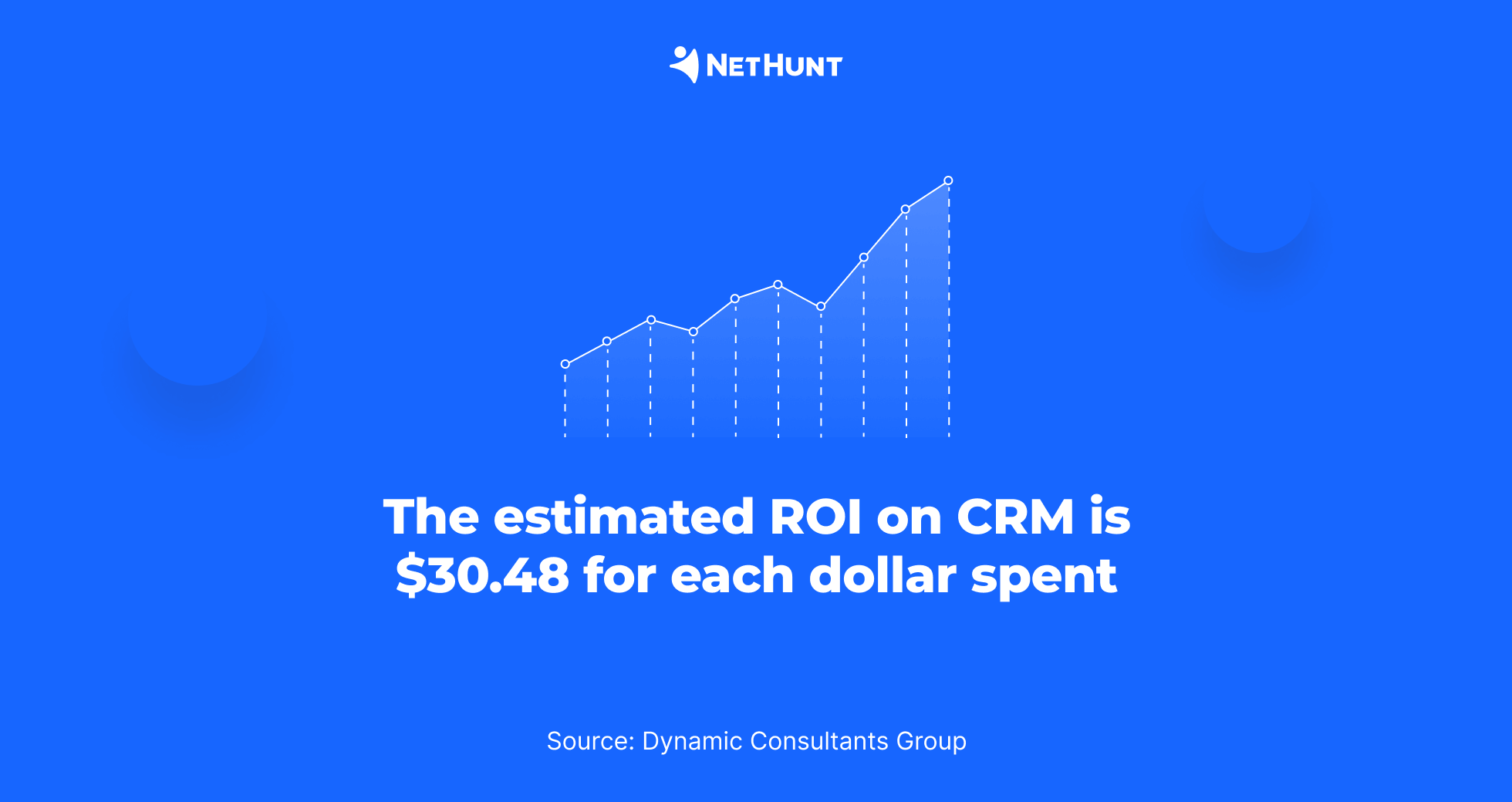
It helps you align your teams
Both sales and marketing teams get real-time access to all the information about leads and customers in the CRM database.
This gives marketers a better understanding of customer behaviour; they can dig deeper and find the downsides of their strategies, discover customer pain points and re-think their strategies way before it’s too late.
On the other hand, the sales team knows exactly what brought each lead into the sales funnel, and crafts a better-personalised line of communication to convert them faster.
It increases your sales
All in all, CRM software allows businesses to optimise their workload, prioritise leads, find better approaches to them, craft more valuable offers, and build better relationships. It leads to an immense increase in sales.
There’s research that suggests that CRM software can improve sales by up to 29%.
It allows you to work from anywhere
In-person meetings are extremely important for the sales process: they help establish a robust relationship, get to know your lead or customer better, and, therefore, allow you to excel at value-based (or solution) selling by adjusting your offer for maximum personalisation.
However, when you’re out of the office, running around the town (or the globe, for all it matters), it can be difficult to keep all the information in one place and remember it in detail. You need a dedicated space to promptly update your information about deals “on the go”.
Thanks to CRM software, you no longer have to depend on your memory when working “in the field”. Modern CRM solutions offer mobile versions of the system that can be accessed via any device connected to the Internet.
We've got even more CRM benefits here
How to get started with a CRM system
Once you make the decision to commit to a CRM system, you’ll need to choose the right suite for your needs.
Now, convincing a team to change anything about the way they normally do things is a difficult process if not done right. We know this, so we decided to help you out in the process and provide you with a CRM implementation checklist that you could follow!
Additionally, we also have a CRM implementation handbook available. It goes more in-depth on CRM implementation, so be sure to check that out!
Want to successfully implement CRM software at your company and leverage all the benefits? Here what you need to do:
- Have your CRM vendor onboard your employees and show them how to use all the features of the CRM. Then, have a CRM training for every new worker who joins the company.
- Migrate all the data from your previous data management system to the CRM.
- Assign an in-house CRM manager that would help people with their CRM-related problems and requests.
- Educate teams of the benefits of up-to-date CRM and prompt them to use it.
- Automate as many of your business processes as possible using the CRM.
- Regularly assess the success of your CRM implementation and adjust your strategy for better results.
Why choose NetHunt CRM
We know, the CRM landscape is crowded. Our solution, NetHunt CRM, stands out for its unique blend of features, security, and customer-centric approach. Here's why you should check us out:
- NetHunt CRM is integrated with Gmail and other Google Workspace tools giving you access to a CRM from your inbox.
- The system is very flexible and helps you tailor it to your specific business processes.
- You can eliminate repetitive tasks with NetHunt’s features like webforms, drip campaigns, and automated workflows.
- All your customer interactions will be in one place. NetHunt integrates with LinkedIn, WhatsApp, Facebook Messenger, and more platforms.
- Our pricing plans are very flexible. They fit businesses of all sizes and there’s a 14-day free trial.
- NetHunt CRM lets you supercharge your email campaigns with tracking and automation features directly from your inbox.
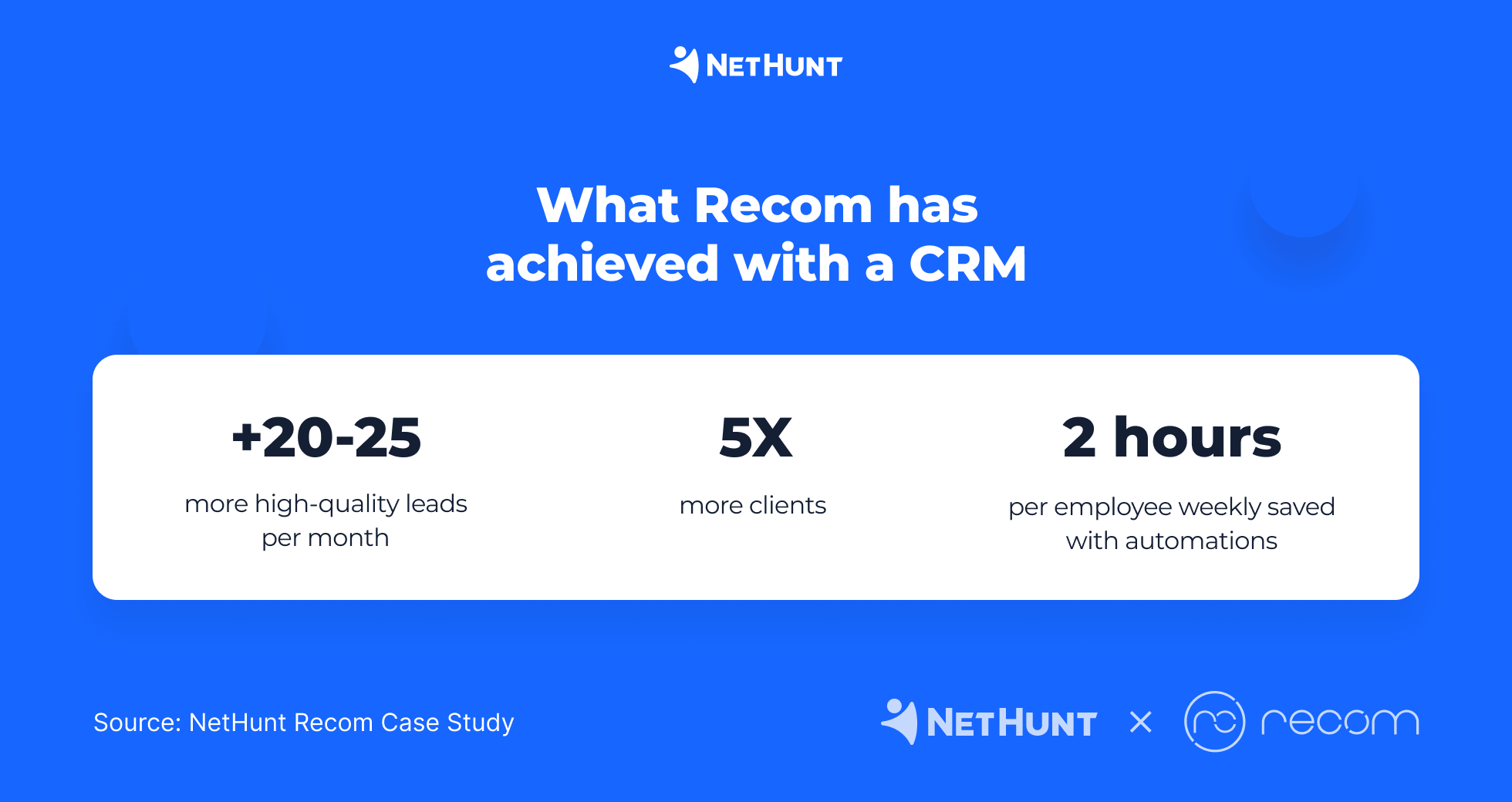
When life gives you lemons — make lemonade. When NetHunt CRM gives you a great feature list, at a very friendly price — start a 14-day free trial!
FAQs
What are the three types of CRM?
CRM systems come in a variety of flavours to meet the needs of various businesses. Generally, they can be categorised into three main types:
Operational CRM
This type focuses on streamlining and automating customer-facing processes like sales, marketing, and customer service. It aids businesses in the management of leads, the conversion of leads into customers, and the provision of service throughout the customer lifecycle.
Analytical CRM
This type is designed with analysis in mind. It gathers information from various customer interactions and analyses it to gain insights into customer behaviour, sales trends, and marketing effectiveness. These insights are used by businesses to make strategic decisions.
Collaborative CRM
This type is intended to improve communication between a company and its customers and within the company itself. It frequently involves sharing customer information between various departments or even between various businesses.
What is the difference between CRM and ERP?
Both CRM and ERP (Enterprise Resource Planning) are computer programmes used for business management. However they serve different purposes and work with various data types.
CRM primarily manages interactions with customers and potential customers. It helps in automating sales, marketing, and customer service processes. The main objectives are to enhance customer service, boost sales, and improve customer relationships.
ERP is a more complete system that controls various business operations and processes. This includes finance, human resources, supply chain, and inventory management. ERP aims to make internal business processes more efficient and improve information flow within the company.
What happens if you run a business without a CRM?
It’s possible to run a business without a CRM system. But why would you? It’s a system that provides a lot of value to your sales and customer service processes.
Here are some challenges you’ll encounter without a CRM:
👉 Data disorganisation : Customer data may be dispersed across numerous platforms or even paper files without a CRM. This makes it challenging to access and analyse information quickly.
👉 Inefficient processes: Manual work takes time and is prone to error. Without a CRM, it’s required for tasks like lead tracking, customer segmentation, and communication.
👉 Poor customer service: Without a centralised system staff members may not have access to customers' full history or preferences.
👉 Missed opportunities: Identifying sales opportunities or improvement areas becomes nearly impossible without analytics and reporting.
👉 Limited scalability: As your business grows, managing customer relationships and internal processes without automation will get difficult.
👉 Reduced competitive edge: Your competitors already use CRM systems to optimize their customer relationships and internal processes. This potentially puts your business at a disadvantage.
And just like that… You understand exactly what CRM is. Congrats!
Table of Contents
Crack the sales formula with CRM Lab
Twice a month, receive actionable CRM content to your inbox.


